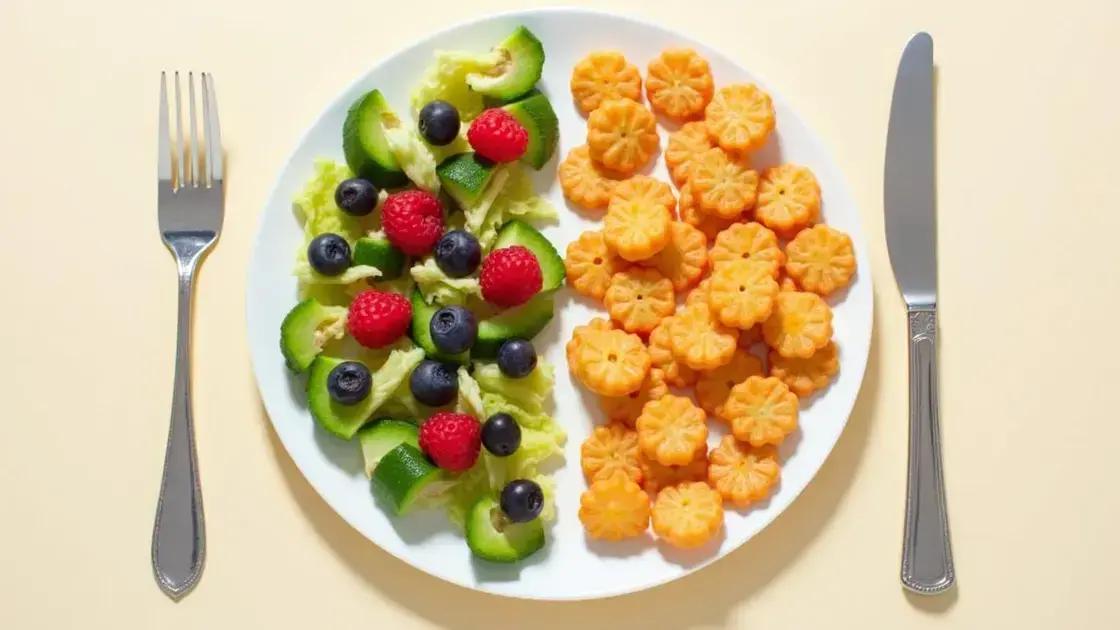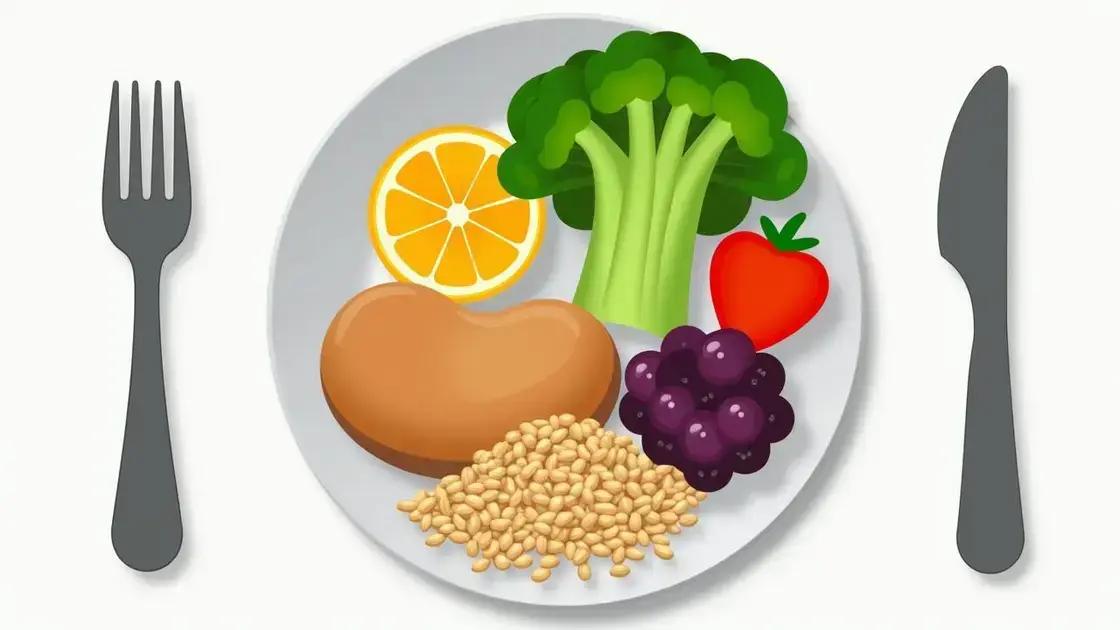Managing cravings with balanced nutrition involves understanding triggers, employing effective nutritional strategies, and incorporating a variety of food groups into your diet. Prioritizing protein, choosing whole foods, staying hydrated, and practicing mindful eating can help control cravings. Additionally, for long-term success, set realistic goals, keep a food journal, and allow flexibility in your eating habits.
Managing cravings can be a challenging aspect of maintaining a healthy diet. How to manage cravings with balanced nutrition offers practical solutions to help you navigate the complexities of hunger and emotional eating. By understanding the science behind cravings, you can implement effective strategies to enjoy a balanced diet that satisfies both your body and mind. This article will delve into techniques and nutritional choices that can empower you to make healthier decisions while still feeling fulfilled.
Understanding Food Cravings

Food cravings are powerful urges that can disrupt our eating habits. They often arise suddenly and demand immediate satisfaction, making it difficult to maintain a healthy diet. Understanding food cravings is the first step in managing them effectively.
What Causes Food Cravings?
Cravings can be triggered by various factors including emotions, stress, and even specific nutrients. For instance, feeling sad might lead to a desire for comfort food. Sometimes, cravings are due to the body lacking certain nutrients, which can lead to a strong desire for foods rich in those nutrients.
Types of Cravings
There are two main types of cravings: physical and emotional. Physical cravings often stem from hunger or nutrient deficiencies, signaling the body that it needs food. Emotional cravings, on the other hand, are linked to feelings such as stress, sadness, or even boredom.
How to Recognize Cravings
Identifying the difference between physical hunger and cravings is essential. Physical hunger builds gradually and can be satisfied with various foods, while cravings typically hit suddenly and target specific foods that are often unhealthy.
Impact of Nutrition on Cravings
Balanced nutrition plays a crucial role in managing cravings. A diet that includes adequate proteins, healthy fats, and fiber-rich carbohydrates can help keep blood sugar levels stable and reduce the likelihood of cravings. When your body receives the nutrients it needs, cravings can decrease significantly, making it easier to stick to healthier choices.
Nutritional Strategies to Combat Cravings

Implementing nutritional strategies can be a powerful way to combat cravings and maintain a healthy diet. Here are several effective methods:
1. Prioritize Protein
Protein is essential for keeping you full and satisfied. Include sources like lean meats, beans, and legumes in your meals. When you’re well-fed with protein, cravings can diminish.
2. Choose Whole Foods
Whole foods such as fruits, vegetables, whole grains, and nuts are high in nutrients and fiber. They digest slowly, which helps control hunger and cravings. Aim to fill your plate with colorful veggies and whole grains.
3. Stay Hydrated
Sometimes, feelings of hunger can actually be signs of dehydration. Drinking enough water throughout the day can help reduce cravings. Aim for at least 8 glasses of water daily, and consider drinking a full glass before meals.
4. Plan Balanced Meals
Planning meals that combine proteins, fats, and carbohydrates can help keep you full longer. A well-balanced plate might include grilled chicken, quinoa, and steamed broccoli. This balance reduces the risk of craving unhealthy snacks.
5. Mindful Eating
Practicing mindful eating can help you recognize true hunger signals. Take your time to savor each bite, and listen to your body. This approach helps reduce impulsive eating and can limit cravings.
Incorporating Balance into Your Diet

Incorporating balance into your diet is crucial for managing cravings and maintaining overall health. Here are some effective strategies:
1. Diversify Your Food Choices
A balanced diet includes a variety of foods from all food groups. Think about incorporating fruits, vegetables, whole grains, proteins, and healthy fats into every meal. This variety not only satisfies nutritional needs but also keeps meals interesting.
2. Control Portion Sizes
Portion control is key to achieving balance. Using smaller plates can help manage serving sizes and prevent overeating. Being mindful of how much you consume can lead to better dietary habits and less frequent cravings.
3. Include Healthy Fats
Healthy fats, such as those found in avocados, nuts, and olive oil, can help promote satiety. Incorporating these fats into meals can keep you feeling fuller for longer and help curb cravings for unhealthy snacks.
4. Regular Meal Times
Establishing regular meal times assists in maintaining energy levels and controlling hunger. Eating at set times prevents the extremes of hunger that can lead to cravings for quick, unhealthy options.
5. Listen to Your Body
Learning to listen to your body’s hunger and fullness cues can aid in achieving balance. When you eat only when hungry and stop when full, you can better manage cravings and maintain a healthy relationship with food.
Tips for Long-Term Success in Nutrition

Long-term success in nutrition is about creating sustainable habits that work for your lifestyle. Here are some valuable tips:
1. Set Realistic Goals
Start with achievable goals that can be easily integrated into your daily routine. Instead of drastic changes, focus on small, consistent improvements, like adding one extra serving of vegetables each day.
2. Keep a Food Journal
Writing down what you eat can increase awareness of your eating habits. A food journal helps identify patterns and triggers for cravings while encouraging you to stay accountable to your nutritional goals.
3. Educate Yourself
Understanding nutrition can empower you to make better food choices. Read books, take classes, or follow reputable health websites. Knowledge boosts confidence and helps you navigate food-related decisions.
4. Allow for Flexibility
Strict diets can lead to feelings of deprivation. Instead, allow for occasional treats and flexibility in your eating. Balance is key, so enjoy your favorite foods in moderation without guilt.
5. Build a Support System
Having a strong support system can make a big difference. Surround yourself with family and friends who encourage healthy habits. Joining a community or group focused on health can also provide motivation and accountability.
Achieving Balance for Long-Term Health
Managing cravings through balanced nutrition is essential for maintaining a healthy lifestyle. By understanding the causes of cravings and employing nutritional strategies, you can make empowered choices that benefit your body and mind.
Incorporating balance into your diet, prioritizing a variety of foods, and practicing mindful eating can go a long way in managing cravings effectively. Remember that long-term success in nutrition comes from setting realistic goals, staying informed, and building a supportive network.
With dedication and the right strategies, achieving your health goals is within reach, making each meal an opportunity to nourish your body and live well.
FAQ – Frequently Asked Questions about Managing Cravings with Balanced Nutrition
What are food cravings?
Food cravings are strong urges to eat specific foods, often triggered by factors like emotions, stress, or nutrient deficiencies.
How can I manage my cravings effectively?
You can manage cravings by prioritizing protein, choosing whole foods, staying hydrated, and practicing mindful eating.
Why is balance important in my diet?
A balanced diet ensures you get a variety of nutrients, helps control hunger, and reduces the likelihood of cravings for unhealthy foods.
What should I focus on for long-term nutrition success?
Set realistic goals, keep a food journal, educate yourself, allow flexibility, and build a support system to aid in long-term nutrition success.
Is it okay to indulge in treats?
Yes, including occasional treats in moderation is important for maintaining a balanced approach to nutrition and prevents feelings of deprivation.
How can I stay accountable to my nutrition goals?
Keeping a food journal and surrounding yourself with supportive friends or joining a community can help you stay accountable to your nutrition goals.












